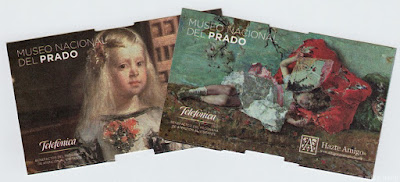Sept. 22
We departed from Ft. Myers airport with more luggage than Ken had hoped for, but a girl needs her accessories and only certain brands of cosmetics and toiletries will do.
Sept. 23
After an all-night flight, we arrived in Madrid, Spain. We managed to get out and see a few sights and eat an early dinner (Spaniards don’t eat until 9 PM or later).
 |
| Plaza Mayor, Madrid |
 |
| Madrid |
 |
| Puerta de Alcalá |
We had pre-booked a flamenco show for our first evening in Madrid, but Jamey was fading fast; her eyelids were closing and her head was bobbing. Despite being in the front row, Ken had to keep punching her to keep her awake even during the stomping, clapping and singing.
 |
| Flamenco Show |
Sept. 24
Today we went on a walking tour of the city.
 |
National Symbol of Madrid:
The Bear and the Strawberry Tree |
 |
| Royal Palace of Madrid |
 |
| Madrid |
Hams (jamones) were hanging from the rafters and in the doorways everywhere! Special porkers (b
lack Iberian pigs) are raised in the mountainous region of Spain where acorns are plentiful. The Serrano cured ham is a delicacy and is sliced thinly and served cold. Spaniards rate their hams like French do their wines.
 |
| Ham Store |
During our tour, we visited the oldest restaurant in Madrid and the world! Casa Botin, opened in 1725 and is listed in the Guinness Book of Records. The restaurant was a favorite of Ernest Hemingway. Its specialty of the house is roasted suckling piglet.
 |
| Preparing Suckling Pig in Casa Botin Kitchen |
 |
| Casa Botin Wine Cellar |
Eating is a passion of ours, especially when we are traveling and have the opportunity to sample local food and drink. We were able to drink and eat our way around Madrid on a tapas and wine tour starting at 8:00 PM. Eating small plates (tapas) is common with the Spaniards. When you order wine or drinks in bars, you are often served a tapa. After all, the more you eat, the more you drink. We had wine at every stop; we tasted a strawberry liqueur (made from strawberries from the strawberry tree) in a chocolate shell; we ate churros dipped in hot cocoa which was so thick you had to eat it with a spoon. We ate ham, olives, crusty breads, paella, and the traditional flan.
 |
| Tapas & Wine Tour |
 |
| Dessert - Flan & Wine |
Sept. 25
Taking advantage of Spain’s wonderful rail system we took day-trips to the cities of Toledo and Segovia.
RENFE (the Spanish national train system) is amazing and often baffling! Tickets are purchased via vending machines. There are many different types of trains and you’ve got to know which one you want and which platform and rail to go to - it was often confusing.
There are several high-speed trains – AVE, Alvia, Avant, Talgo, Intercity and Electro. The Rapido, Tranvia, Semidirecto, and Expreso trains are generally slower. Cercanias and Rodalies are commuter trains for city workers and tourists; Regional and Correo trains are slow, small-town milk runs. The faster the trains travel and the fewer the stops, the more expensive the fare.
 |
| Boarding the High-speed Train |
Toledo is a small, walled, medieval town, bordered on the west, south, and east by the Tagus River. It is one of the most visited sites in all Spain; its history dates back to Roman occupation. The streets are winding and cobbled. It has been denoted a UNESCO heritage site.
 |
| Toledo's Train Station |
The cathedral is in the center of the city. In its early history, Arabs, Jewish, and Catholics lived together, peacefully. The Arabs brought their beautiful artistry of Damascene and ceramics. The Damascene technique uses gold threads and heat to produce masterful pieces.
 |
| Cathedral |
 |
| Damascene Plates |
 |
| Tagus River |
Sept. 26
Another day, another train trip. This time to Segovia.
Segovia is a World Heritage City. As with other cities in Spain, it is hilly. We walked through the old Jewish quarter, under and around the remains of the old Roman aqueduct, and to the cathedral.
 |
| Roman Aqueduct |
 |
| Av. Fernandez Ladreda |
The view of the massive Roman aqueduct greets visitors as they approach the city. Other notable sites in Segovia are the flamboyant Gothic style cathedral and the Corpus Christi Convent/Franciscan church (it once was a synagogue and a mosque). We walked through town to the Alcázar, originally a palace, then a prison and finally a Royal Artillery School until it burned in 1862. Now it’s a museum.
 |
| Cathedral |
 |
| View From City Wall |
 |
| Segovia |
 |
| Alcázar |
 |
| Moorish Stonework in Segovia |
Sept. 27
On our final day in Madrid we walked to Buen Retiro Park and strolled through its beautiful gardens. Later we visited the Museo Nacional del Prado, considered to be one of the world’s great art museums. We arrived early and waited in line for free entry from 6-8 PM.
 |
| Grounds of Retiro Park |
 |
| Retiro Park Crystal Palace |
 |
| Retiro Pond and Monument to King Alfonso XII |
 |
| Tickets to Museo del Prado |



























